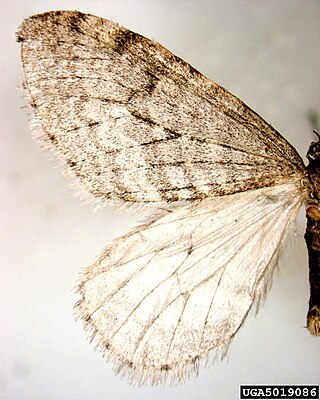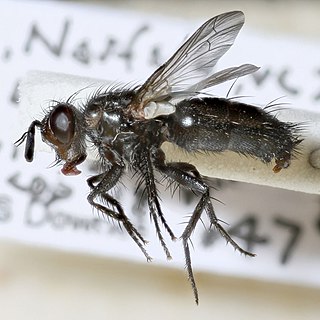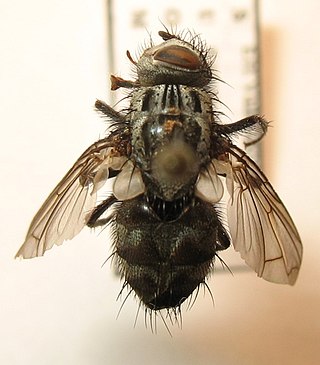
The winter moth is a moth of the family Geometridae. It is an abundant species in Europe and the Near East and a famous study organism for evaluating insect population dynamics. It is one of very few lepidopterans of temperate regions in which adults are active in late autumn and early winter. The adults use endothermy for movement in these cold temperatures. The females of this species are virtually wingless and cannot fly, but the males are fully winged and fly strongly. After the initial frosts of late fall, the females emerge from their pupae, walk to and up trees and emit pheromones in the evening to attract males. After fertilization, they ascend to lay, on average, around 100 eggs each. Typically, the larger the female moth is, the more eggs she lays.

Besseria is a genus of flies in the family Tachinidae.

Blepharomyia is a genus of flies in the family Tachinidae.
Acemya acuticornis is a species of fly in the family Tachinidae. It is a parasitoid of solitary locusts and can be found in from West Europe to Mongolia.

Operophtera bruceata, the Bruce spanworm, hunter's moth, or native winter moth is a moth of the family Geometridae. The species was first described by George Duryea Hulst in 1886. It is found from coast to coast in southern Canada and the northern parts of the United States.
Brachicheta stricata is a species of fly in the family Tachinidae.
Clemelis pullata is a species of fly in the family Tachinidae. This family consists of dipteran tachina flies, which are protelean parasitoids of arthropods.
Cinochira atra is a species of fly in the family Tachinidae.

Phasia pusilla is a European species of fly in the family Tachinidae.
Micronychia ruficauda is a European species of fly in the family Tachinidae.

Macquartia tenebricosa is a European species of fly in the family Tachinidae.

Germaria angustata is a species of tachinid flies in the genus Germaria of the family Tachinidae.

Blepharomyia piliceps is a species of fly in the family Tachinidae.

Campylocheta inepta is a species of fly in the family Tachinidae. It is found in the Palearctic. This species is a parasite of mainly Geometridae larvae but also several other families of Lepidoptera associated with heathland and moorland. Campylocheta inepta occurs in montane areas with pine forests in most of Europe but the species is also found in lower areas in central Europe and Spain.

Agrypon flaveolatum is a species of parasitoid wasp belonging to the family Ichneumonidae described by Johann Ludwig Christian Gravenhorst in 1807. It is a parasite of the larva of the winter moth, and has been used in biological pest control to control this moth, whose larvae feed on foliage and defoliate trees.

Billaea triangulifera is a species of fly in the family Tachinidae. It is a parasitoid of larval Prionus coriarius beetles, piercing the beetle near its spiracles.
Nephrocerus flavicornis is a species of fly in the family Pipunculidae.
Aplomya confinis is a European species of fly in the family Tachinidae. It is a parasitoid of the Purple hairstreak.
Elodia ambulatoria is a species of tachinid fly in the genus Elodia of the family Tachinidae. It is a parasitoid of Archinemapogon yildizae.

Platymya fimbriata is a species of bristle fly in the family Tachinidae.











